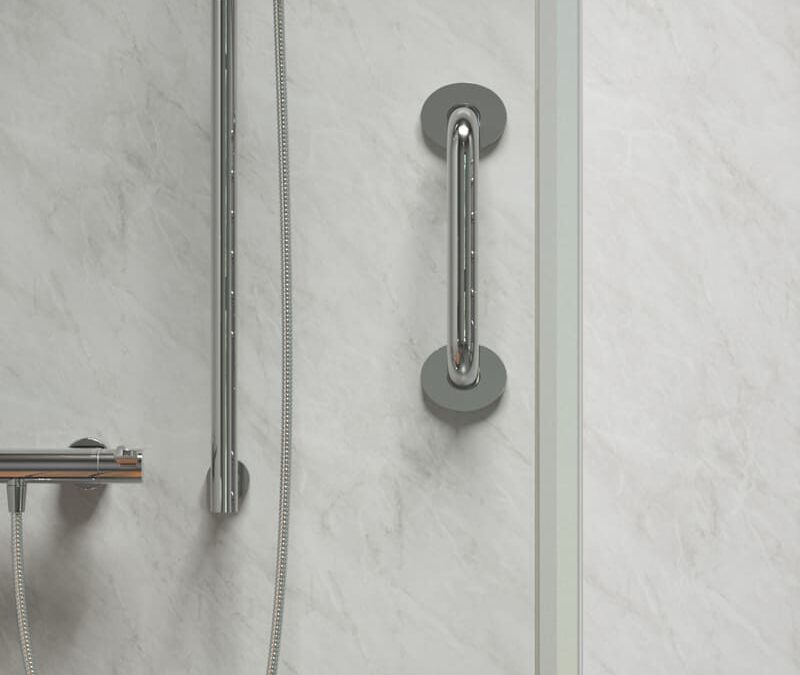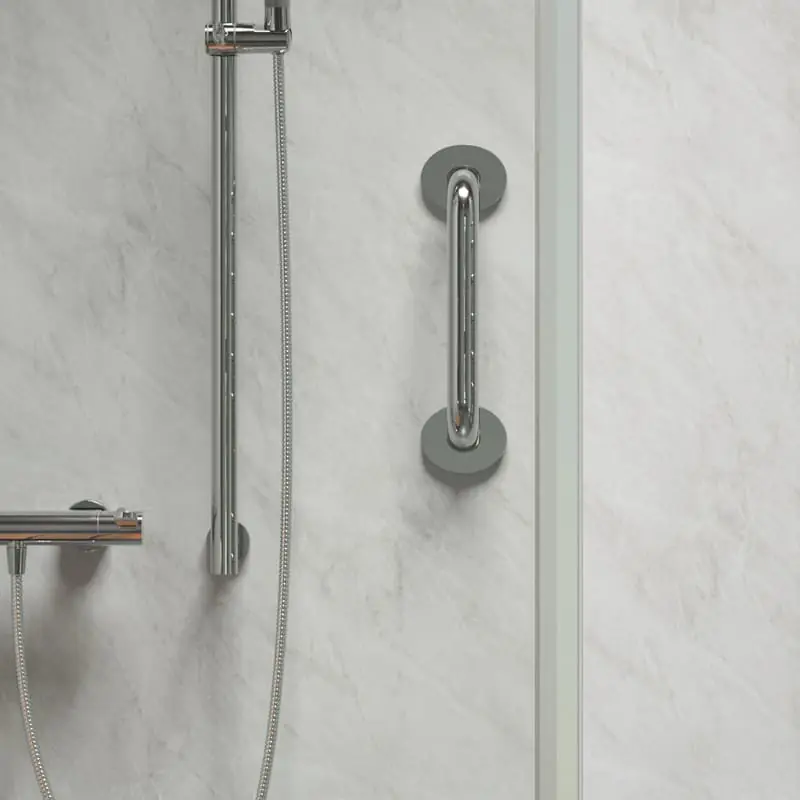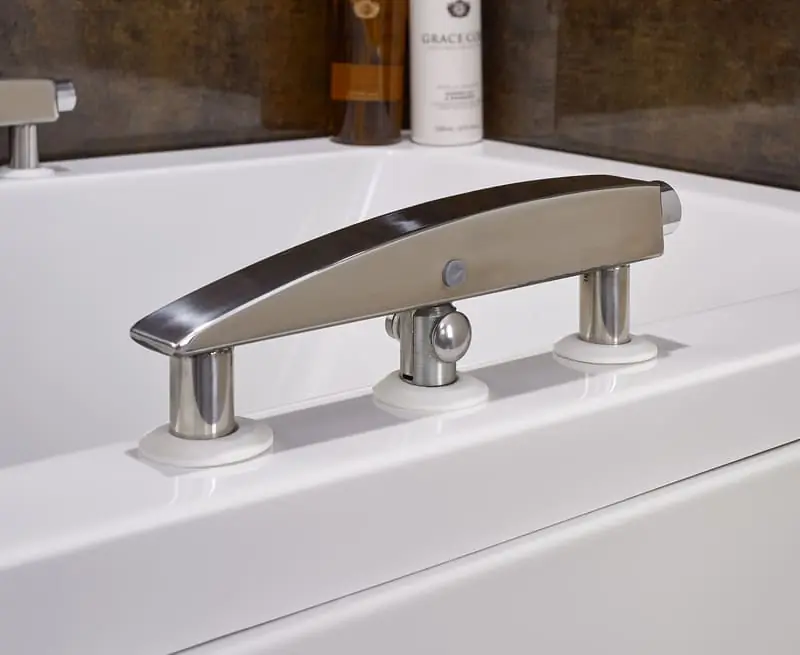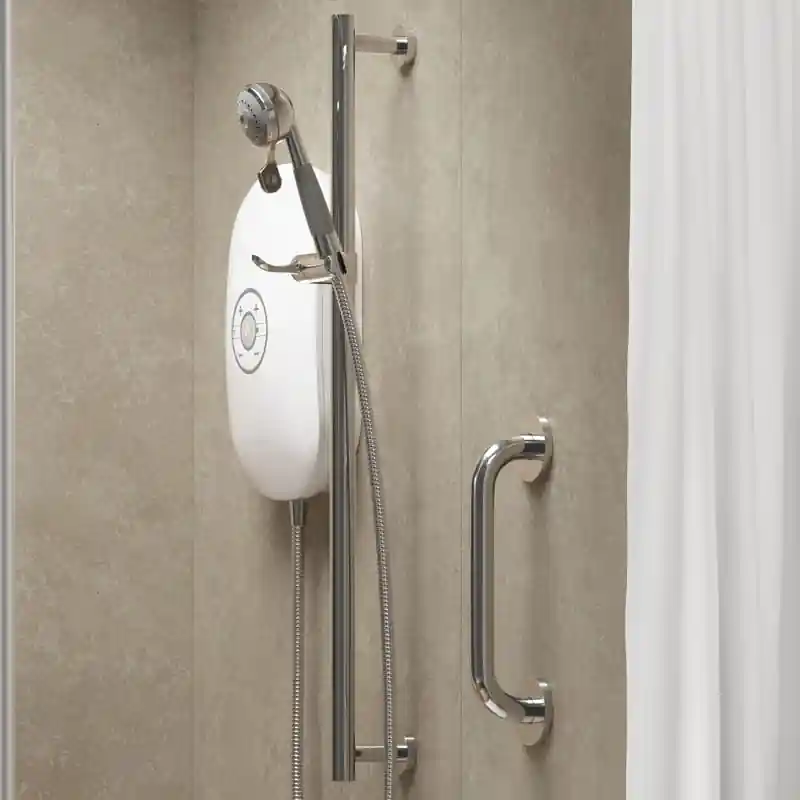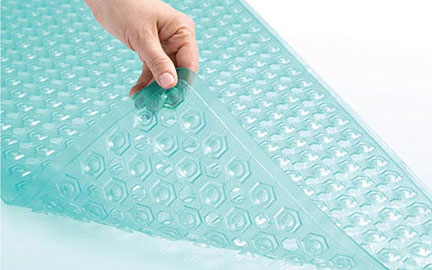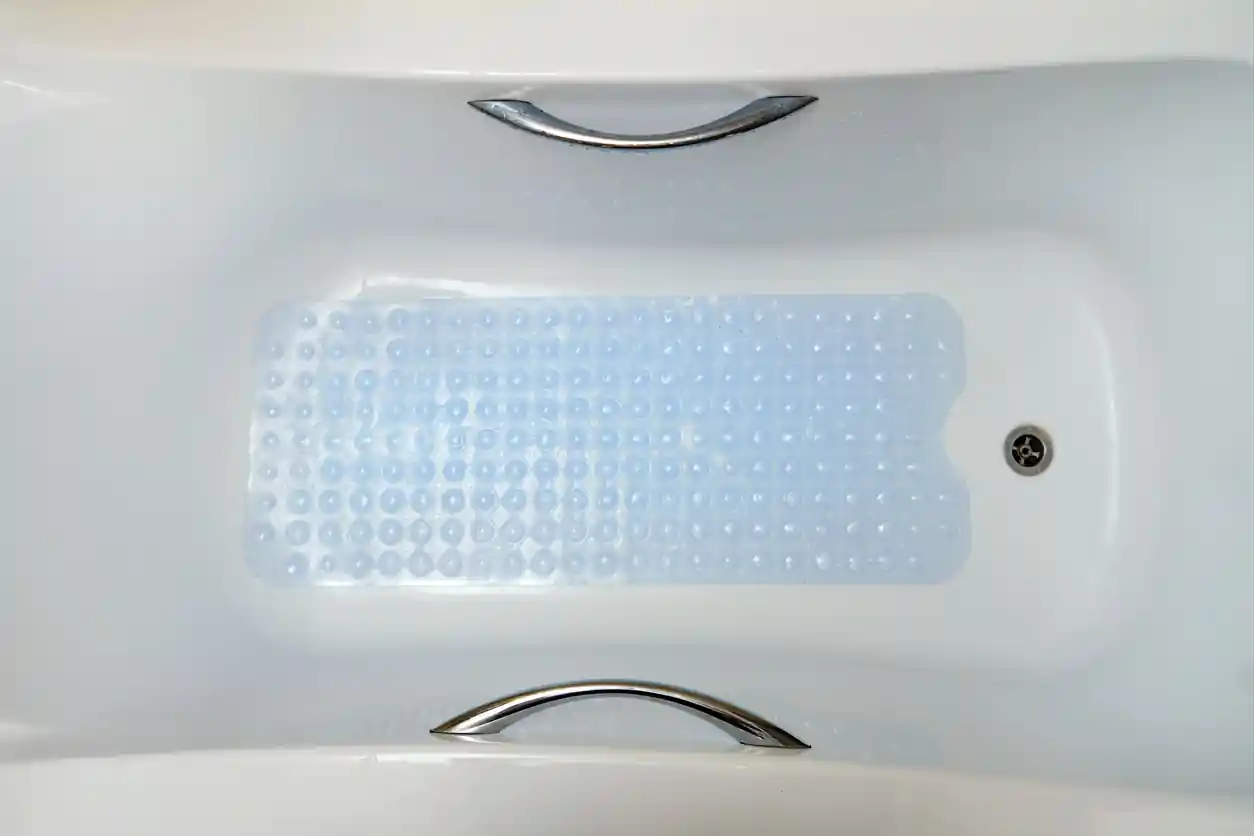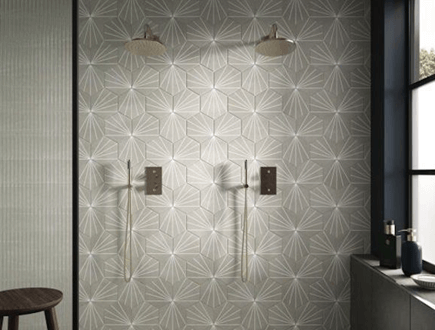
by Jon Pearce | 3rd Nov, 2023 | Inspiration

Wet rooms are simple and stylish parts of any bathroom. They’re also ideal for users with limited mobility. Why’s that? Because they’ve zero steps, doors, or awkwardly positioned shower heads to worry about.
But what is a wet room, exactly? Simply put – they’re waterproofed, open-planned spaces with drains flush with the floor. In contrast, shower rooms typically feature an elevated floor tray and numerous glass partitions.
Looking for inspiration? You’re in the right place. This page is awash with beautiful wet room ideas, suitable for every taste, budget, and disability needs. We’ve also included example images from Pinterest for an extra splash of inspiration.
Now, let’s get started…
- Decorative tiling ideas
- Wet room flooring ideas
- Using contrasting materials
- Disabled wet room ideas
- Different seating styles
- Small wet room ideas
- Wet room heating solutions
- Vintage style wet room ideas
- Well-positioned toilet and basin
- Budget-friendly wet room ideas
- Spa-like wet room ideas
- Wet rooms using light
- Various shower fittings
- Creative and useful drainage solutions
- Partition styles
- Clever storage ideas
- Using plants
- FAQs
Request a Free Brochure
Simply fill out a quick form and see how we can transform the way you bathe.
Request Free Brochure
Decorative tiling ideas
Tiles or easy-clean wallboards are vital to the wet room. In fact, we’d say that no list of wet room ideas is complete without them being mentioned. That’s why we’ve picked out three suggestions, differing in texture, colouring, and pattern.
1.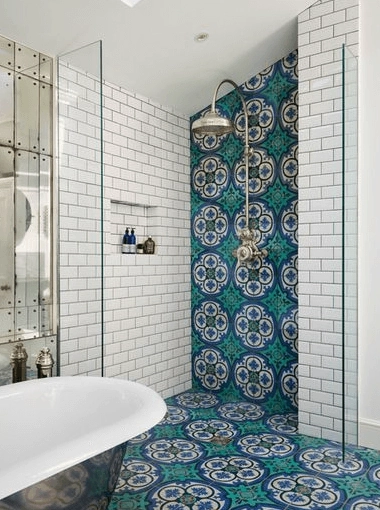
Original owner: RusticoTile
This beautiful, Victorian wet room makes a splash with its feature wall, offsetting the white tiling with its glorious, turquoise patterns. It’s nothing if not easy on the eye.
2.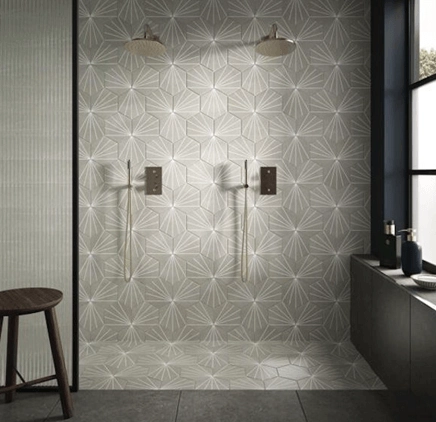
Original owner: Verona Group
This bright, sparkly, constellation of tiles offers a variety of patterns and textures – turning your washing routine into an astronomically pleasant experience. The clever use of white grout gives that striking, star-like effect. Bravo.
3.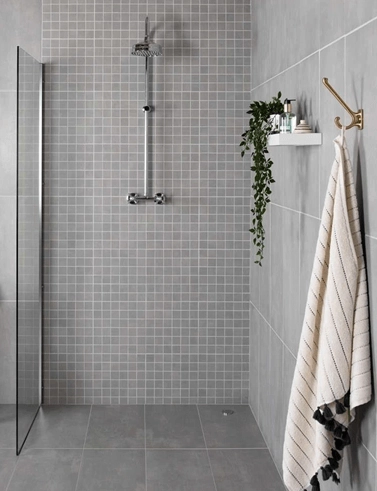
Original owner: Drench.co.uk
Looking for minimalist wet room ideas? Then this tiling job is for you. It’s two patterns with one colour. In our expert eyes, it’s a classic.
Wet room flooring ideas
No matter your geographical location, this terracotta-tiling would transport you directly to your favourite Mediterranean holiday. It’s simply beautiful. And contrasted against white micro cement walls and golden pipes? That’s amore.
4.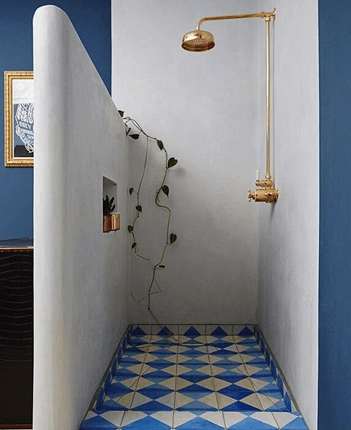
Original photo by: Mike Pilkington
Using contrasting materials
Why should tile designs get all the contrasting fun? You can also play with the materials themselves. Slate, wood, and glass contrast in the wet room below, creating one of the most contemporary wet room ideas on our list.
5.

Original owner: JIS Sussex
Disabled wet room ideas
Wet rooms are ideal for shower-lovers with limited mobility. With no steps or doors, they’re easily accessible and require very little maintenance. In this section, we’ve selected a wide range of disabled wet room ideas to get you thinking about bathrooms and how mobility is an important factor that should be considered.
6.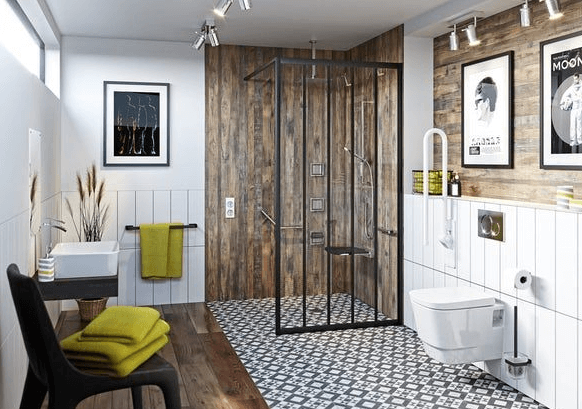
Original owner: VictoriaPlum
This wet room has it all: contrasting materials, spectacular tile designs, folding seats, and a selection of handrails for extra support. As far as disabled wet room ideas go, this one ticks every box.
7.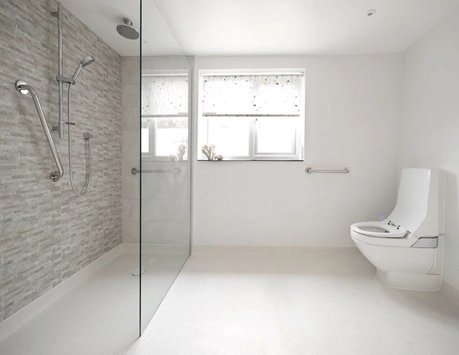
Original owner: Altro.com
Spacious, stylish – this wet room uses whitespace and natural light to great effect, with subtle, silver handrails matching the shower piping. It even features a raised toilet seat for added comfort. To learn more about the benefits of raised toilets as you age, please read our helpful guide on this subject.
8.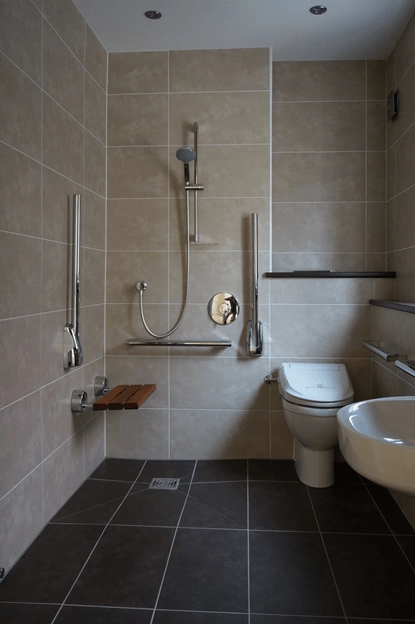
Original owner: AJT Showers
With its natural stone flooring – one of the most slip-resistant materials – this wet room is safe and stylish in equal measure. That’s not to mention the raised toilet seat and floating basin, ideal for wheelchair users. Psst: other non-slip surfaces include ceramic tiles, non-slip vinyl, and cork.
9.

Original owner: MotionSpot
Overhead lighting combines with dark tiling to create a cinematic atmosphere, with built-in. This particular disabled wet room idea covers the basics, but to an excellent standard.
Different seating styles
From built-in benches to heated seats, you’ve plenty of choice when it comes to resting those legs. The best bit? Wet room seating can be enjoyed by all ages and mobilities. Below, we’ve picked out some sumptuous seating arrangements.
10.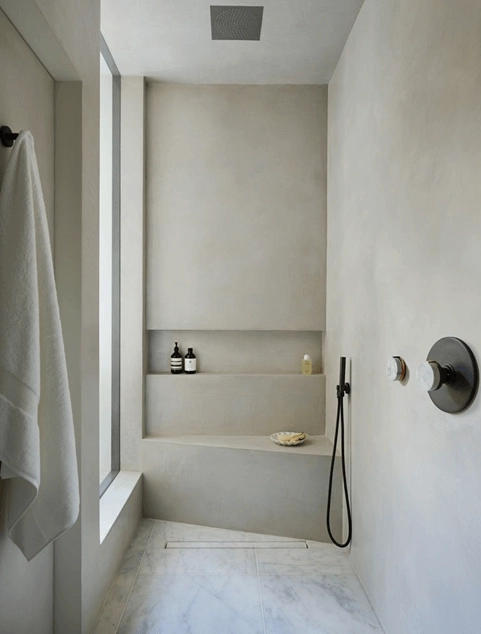
Original owner: Tadelakt London
Discreet in design, this built-in bench uses a triangular shape to save space, while looking easy on the eye. Given its size, it’s not really for sharing, but this wet room would be your happy place, so who cares?
11.

Original owner: Rob O’Danie
The wooden seat oozes natural, rainforest vibes – especially when paired with that rainfall shower head. Though technically a walk-in shower, this is still one of our favourite designs. You also have contrasting materials here, which we love.
12.

Pexels: Curtis Adams
You can build a seat into your wet room by simply adding a ledge beneath the shower head. This is simple, stylish and effective.
13.

Original owner: BankHouse
Despite the tiling, the first thing catching your eye is the seat. It’s humble, comfortable, and looks great. Best of all, you have the flexibility to move it to wherever you please.
Small wet room ideas
Wet rooms are only for big bathrooms, right? Wrong! You can easily turn your loft or ensuite into a cosy wet room – simply by fixing a shower head to the ceiling. Of course, you can be more adventurous than that, as you’ll see further down the page.
When it comes to wet room conversions, you just need to know how to make the most of your limited layout. But don’t worry, that’s why we’re here. We’ve got some space-saving, small wet room ideas for you right here.
14.

Original photo: Anthony Masterson
Lofts lend themselves nicely to small wet rooms. Why? Because they’re snug areas already. As the example above shows, these particular rooms typically come with toilet-height walls, slanted ceilings for natural light, and a corner wall – where you can easily fit a showering space.
15.

Original owner: Emily Followill
Take your toilet. Waterproof the tiling. Install a shower head. Hey presto! You’ve a small wet room. We particularly love the white tiles here, and their ability to ‘enlarge’ the space.
16.

Original owner: Jean Allsopp
This attic-style wet room feels larger than it is, thanks to the natural light, well-positioned mirrors, and the light within the shower area. This small wet room idea shows you only need a few strategically-placed features to create a winner.
Wet room heating solutions
We’ve already touched upon heated seating, but you can do so much more than that. Loved by humans and cats alike, underfloor heating can help soothe achy legs on those frosty mornings. Bliss.
What’s more, it’s important that you put your radiator in the right position – it should be at least one metre from the shower to prevent soapy splashes spoiling the paint. Or, you could install a large heated towel rail in lieu of your radiator.
17.

iStock: Gamespirit
This is one of our favourite heating-related wet room idea. The ceiling-high radiator adds height to the room, and it’s safely tucked away from the splash area – it ticks all boxes. Tie that in with underfloor heating, and you’ve got one cosy wet room.
Vintage style wet room ideas
Think ‘wet room’ and what normally comes to mind is minimal and modern. But, at Mobility Plus, we love bathrooms from all eras, for all ages. Vintage wet rooms are timeless and – when done well – they’re irresistible. So, we’ve picked out some beautifully vintage wet room ideas below.
18.

Original owner: Michael Sinclair
The octagonal mirror, curtained basin, wooden beams, copper piping – these features turn this farmhouse wet room into a stunning time capsule. The glass partition adds a 21st Century splash, but the room as a whole retains a vintage feel.
19.

iStock: Sergeyryzhov
This time, you’ve got vintage features designed for the modern day. The taps and the shower head are the perfect blend of contemporary and classic, while the dark blue paint and white features combine to create a sumptuous space.
Well-positioned toilet and basin
Ideally, your wet room’s toilet and basin should be close together. That way, you can wash and refresh quickly and easily, with minimal risk of slipping – ideal for wheelchair users or those with limited mobility. It also looks neat, tidy, and compact. Check out the example below to see what we mean…
20.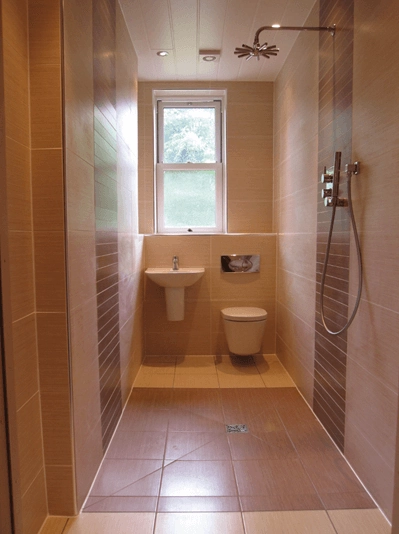
Original owner: Buchanan Bathrooms
Budget-friendly wet room ideas
Tight budget? No problem. You can build a beautiful wet room without splashing the cash. Picking the right features is key. That is, choosing the most cost-effective tiling, drains, partition, and shower head.
Typically, the most affordable tiles are:
- Porcelain/ceramic
- Standard vinyl
- Concrete
- Luxury vinyl
Most wet rooms are open-plan and have no partitions. That said, it would be more budget-friendly to use a single pane of glass as your partition, rather than build an entire wall. For some inspiration, see the wet room idea below.
21.

Pexels: Anna Tarazevi
Spa-like wet room ideas
Wet rooms are luxurious. However, Spa-themed wet rooms offer unrivalled levels of comfort, with multiple shower heads, steam features, and comfortable seating on which you can while (and wash) away entire evenings.
Naturally, spa-like wet rooms are not budget-friendly. They’ll cost a pretty penny. But can you really put a price on that kind of experience? Check out our example below to see those spa features in action.
22.

Original owner: Mark Lohman
Wet rooms using light
Artificial? Natural? Whichever your poison, we believe lighting is an essential part of any aesthetically-pleasing wet room. Now, lofts are ideal spaces for natural light lovers. That’s because rooftop windows don’t typically need frosting, which allows even more sunlight to beam through.
It’s no attic, but our example wet room below features both artificial and natural light options. The tall, frosted, ceiling-height window carries sunny rays during the day, offering a lovely, natural experience. Then, as night falls, this wet room’s two ceiling lights bathe the room in calming hues. It’s the perfect lighting combo.
23.

Original owner: Laura Moss
Various shower fittings
Love showers or shower pods? Got the budget? Then treat yourself to numerous shower heads – we won’t judge. With multiple fittings and a digital shower to operate them, you’ve got a shower for every mood. You can jet wash your senses on Monday morning, then rest under rainfall come Friday evening.
The wet room idea below has more shower fittings than you could shake a stick at. And we love it.
24.

Original owner: John Granen
Creative and useful drainage solutions
Using your budget on the drain? It might sound like you’re throwing your money down there. We disagree. Creative, unique drains can turn your basic wet room into a showpiece, offering both logistical and eye-catching purposes.
For instance, you can position it as the wet room floor’s centrepiece, or use it to gather water into one corner to make your maintenance even easier.
Below, you’ll find one of the more uniquely designed wet room ideas on our list, particularly where drainage is concerned. It’s simply two lines running along the bath, providing a stylish, symmetrical shape. Simple, yet brilliant.
25.

Original owner: Werner Straube
Partition styles
Partitions are the wet room peacekeepers. They protect your carpet, artwork, and toilet-users from unwanted soapy splashes, removing the need for mopping up, or bickering with soaked loved ones. They also afford privacy, of course.
The most popular styles of partition are clear glass, frosted glass, and walls built into the bathroom layout. The example below uses the latter, using an almost-ceiling height wall partition to add privacy without taking too much natural light away from the shower area.
26.

Original owner: Ellie Lillstrom
Clever storage ideas
As you now know, partitions keep the peace. But you can also use them to keep your things. Literally. As the wet room idea below shows, you can turn your partition into a linen cupboard, laundry bin, or generic storage space. That’s multiple birds, one stone.
Clever storage ideas such as this are ideal for small wet rooms, maximising space and freeing up storage elsewhere in your house.
27.

Original owner: Brie Williams
Using plants
Plants in a bathroom bring many benefits. We all know that. But adding them to your wet room can transform your steamy shower into a real-life, beautiful jungle. You just need to use plants that enjoy the humidity.
The best plants for wet rooms include:
- Calathea
- Spider plant
- Peace Lily
- Sarracenia (trumpet pitcher plant)
- Heartleaf Philodendron
Below is one our greenest wet room ideas. It’s surely one of the best places to wash away your green fingers, with multiple plants adding not only colour, but a sense of nature. With the skylight bringing natural rays, you can imagine closing your eyes and taking yourself to a rainforest waterfall.
28.

Unsplash: Curology
We’ve shown you 28 breathtaking wet room ideas, ranging from the beautiful and budget-friendly to the extravagant and lavish. Now, whatever your taste, budget, or range of mobility, you should now feel inspired to find the perfect wet room for your home.
That’s where Mobility Plus can help. We’re wet rooms experts, offering bespoke bathrooms suited to your exact needs. Our job is to help you bathe with confidence and independence – in a wet room you love to call your own.
FAQs
Can you make a wet room in a small bathroom?
Yes, absolutely. If there’s space to stand up, you can turn the smallest bathroom into a beautiful wet room. You just need to waterproof the floor and walls, then install a shower with or without a partition – that just depends on your budget or taste.
What size should a wet room be?
With wet rooms, there’s no one-size-fits all. You can turn any-sized bathroom into a wet room, as long as there’s room to stand and wash. That said, the most popular size is 1200 x 900 mm.
What are the best disabled wet room ideas?
Wet rooms designed specifically for disabled users will feature handrails, seating, and non-slip flooring. You can also install lifted high-raise toilet seats for extra comfort, and floating basins – ideal for wheelchair users.
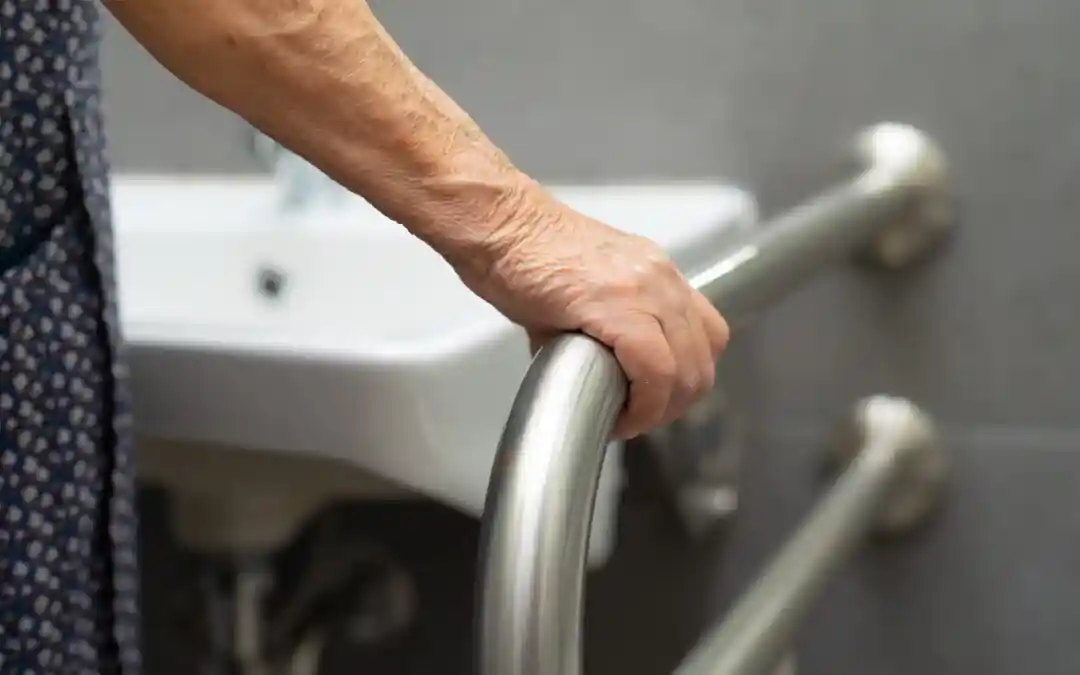
by Jon Pearce | 26th Oct, 2023 | Inspiration
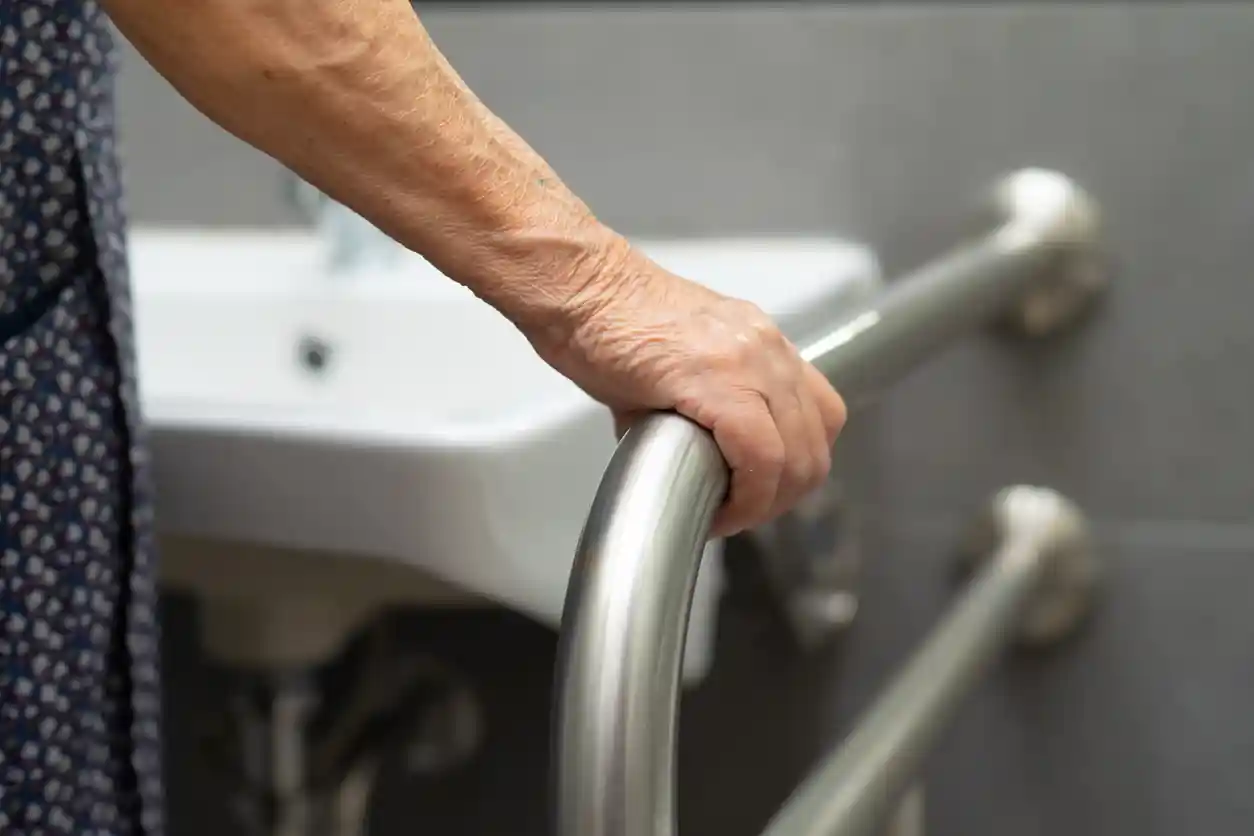
There is no better feeling than stepping out of the shower or bath feeling fresh, clean and relaxed. Unfortunately, the fear of slipping or the lack of independence can make washing uncomfortable for people with mobility challenges. But it doesn’t have to be that way.
If you or a loved one have mobility problems, disability washing aids are a fantastic way to help. In this article, you’ll find the best aids for showering and bathing. Read on to discover our top disability washing aids.
Request a Free Brochure
Simply fill out a quick form and see how we can transform the way you bathe.
Request Free Brochure
- What are washing aids?
- The benefits of disability washing aids
- Reasons you might need a washing aid
- Best showering aids
- Best Bathing Aids
What are washing aids?
Aids for washing and bathing are different types of equipment that make cleaning in the shower or bath easier. They benefit anyone who needs assistance washing or support for pain and balance issues.
There is a vast range of aids, from walk-in showers and baths to transfer benches and folding seats to a variety of grab rails. The type of aids for washing and bathing depends on the individual’s mobility or disability, space in the bathroom and shower size.
The benefits of disability washing aids
Washing aids can transform people’s lives, allowing for a pain-free, easy, enjoyable washing experience. They are an excellent option if you live alone or are a carer who needs to give your client a helping hand. Here are some of the incredible benefits of aids for washing and bathing.
- Increases safety – If you struggle to manoeuvre yourself or have balance issues, getting in the shower or bath can be dangerous. But with a washing aid, you can wash safely for better peace of mind.
- Better for carers – If you are a family member or carer, then it is vital to be aware of your mobility. Lifting anyone incorrectly or who is too heavy can cause permanent back issues. However, a washing aid helps you transfer a person with ease.
- Makes bathing enjoyable – When you are worried about slipping, it can cause fear and anxiety. As a result, many people with mobility issues avoid showering. But that won’t be the case with a shower or bath aid.
- Increases independence – It can be frustrating if you want to bathe by yourself but rely on others to help you in and out. A washing aid could give you the freedom to bathe or shower independently.
Reasons you might need a washing aid
You could benefit from a bathing or showering aid for many reasons, and it’s unique to the individual. Below are some common reasons a person may require help washing:
- Arthritis
- Little or no mobility
- A learning disability
- Physical illness
- Recovering from an operation or injury
- Elderly
Best showering aids
Showering is energy-saving and water-efficient. However, the bottom of a shower gets slippery, and it can be challenging to stand for the required time to clean. Here are some of the best shower aids for elderly and disabled users.
1. Walk-in showers
We had to start with the hugely beneficial aid, walk-in showers. Although they are not an individual component, they are great for helping those with disabilities. Our walk-in showers don’t require you to step over any raised surface. We have various sizes to accommodate anything from balance issues to a roll-in shower chair.
2. Shower stools and seats
There is a wide range of shower seats and shower stools for safety. These include budget-friendly options that you can choose to suit your specific mobility or disability. Find the best shower chairs for the disabled below:
- Standard shower stool – This is a stool for bathroom safety that you can pop in the shower. It is ideal for those with a small shower space who need to take breaks while showering or prefer to stay seated.
- Shower chair – Chairs are beneficial for back support and provide comfort while washing.
- Folding or hanging chair – You can choose chairs attached to the wall of your shower that fold down to sit on. They are great space savers if you have a small shower cubicle.
- Rolling shower chair – If you or someone else cannot stand due to a disability, pain, or discomfort, a rolling shower chair will help. They work in wet rooms or walk-in showers, so you do not need to lift the person.
3. Easy temperature control
Temperature control on showers can be tricky if you have a mobility challenge. Reaching to turn the handle up and down is fiddly and dangerous if turned too hot. Our digital showers have built-in temperature control. You can alter the temperature using a simple touch button or wireless remote control.
4. Different shower head sprays
Washing hair in the shower is challenging if you cannot lift the shower head or the jet isn’t strong enough to rinse your hair. That’s why a variety of shower head spray settings make the best hair washing aids.
Our walk-in showers have four types of shower heads. They use Flipstream technology so you can adjust to the ideal spray setting and easily wash your hair.
Best Bathing Aids
Nothing is better than a warm, relaxing bath. But the older you get, the harder it becomes to lower yourself in and out of the tub. Over time, you may be unable to have baths altogether. Therefore, washing aids for elderly people are vital for a comforting bath. Read on for the best bathing aids.
5. Walk-in baths
Walk-in baths are a wonderful way to enjoy a soak without stepping in and out of the tub. We have a variety of walk-in baths, including ones with low-entry and wide-opening doors for accessibility. At Mobility Plus, we ensure all our baths are compact, easy to use and stylish for an enjoyable bathing experience.
6. Grab Rails
Grab Rails are a simple and budget-friendly washing aid. They offer stability and support for anyone with mobility issues. You can use them to pull yourself up and lower yourself into the bath, reducing the worry of slipping.
There are different types of grab rails, including ones that fix onto walls or use suction. Fixed grab rails are ideal if you own or live in your house long term, as they are durable and reliable. Suction grab rails are perfect for travelling or visiting friends or family for support and mobility.
7. Transfer bench and bath seats
A transfer bench or bath seat is a portable bench you place across the bathtub. It enables users to sit and shuffle over the bath rather than lowering directly into the water. They are helpful if you find getting down and pulling yourself out of the tub difficult or painful.
You can also use transfer benches to stay seated while you wash. You can invest in an independent transfer bench or a built-in one if you have a walk-in bath.
8. Touch button and bath fillers
Bending over and turning taps on and off puts a lot of strain on your hands, especially if you have brittle bones, muscle loss or arthritis. A touch button prevents the discomfort of using taps, while a bath filler smoothly blends hot and cold water to the desired temperature.
9. Bath steps
Bath steps are similar to low stools and help anyone with mobility struggles to step in and out of the tub. They reduce the risk of slipping and minimise discomfort when transferring into the bath. They are good for anyone who has balance issues or stiff joints.
10. Bath lifts
Bath lifts, as washing aids, are handy for those with disabilities who have little to no movement. Bath lifts are built-in, and the user sits down before being mechanically lifted in and out of the bath. They prevent carers of family members from hurting themselves during the transfer and are quick and easy to use.
11. Bath hoists
A bath hoist is a pole outside the tub with a chair or sling attached. Once the individual is seated, the electric hoist over the tub lowers the person into the bath. As washing aids, they usually come with a remote control and are a more budget-friendly and space-saving option to a bath lift.
12. Bath mats
Bath mats are handy for everyone, with or without mobility issues. They provide a safe, comfortable layer over the slippery surface of a shower or tub.
There are two types of bath mats. One uses suction cups and has a waterproof surface that you can place inside the tub to stop you from sliding as you step in. The other is positioned outside the bath to make stepping in and out easier. It is made from an absorbent fabric with a rough underside to grip the bathroom floor and prevent the risk of slipping.
13. Bath pillows
Bath pillows are beneficial if you love relaxing in the bubbles but need neck support. They use suction cups to stick on the tub and prevent you from sliding.
You can get small bath pillows or large ones that support your back and sides. They are helpful if you struggle to stay sitting because of balance, muscle weakness, pain or mobility.
Choose the best disabled washing aid with Mobility Plus
You don’t have to shower in discomfort or sacrifice baths when you have a washing aid. Invest in a walk-in shower or bath, or use alternative options like grab rails, shower seats, and bath fillers for a relaxing experience. With a vast array of choices, we know you will find the right aid.
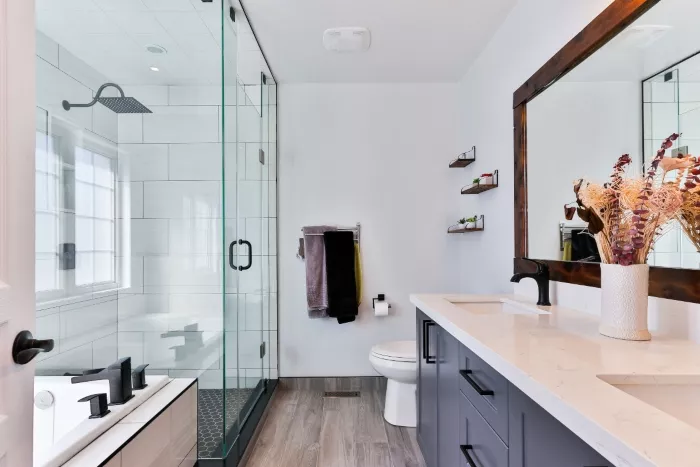
by mobilityplus | 11th Oct, 2023 | Inspiration

The term ‘accessible bathroom’ may conjure up a dull and off-putting image of clunky bathroom aids and a clinical appeal but luckily, that is no longer the case. Thanks to modern design, accessible bathrooms can have can be just as trendy as any other bathroom and be perfectly safe and easy for everyone to use.
At Mobility Plus, we don’t believe you need to sacrifice style in order to achieve a bathroom that is practical and suits your mobility needs. That’s why we’ve put together 5 ideas to help you make your bathroom an attractive haven while making it fit for purpose.
Minimalistic tiles
A key bathroom design trend in 2019 is minimalism: clean and uncluttered spaces with flourishes of character that create a calm oasis to help you to unwind. You can achieve this look easily by selecting some chic minimalistic tiles that will instantly update your bathroom’s look and feel. There are plenty of options to explore, from classic monochrome to vintage-inspired patterns. Meanwhile, by choosing non-slip floor tiles, you’ll be adding an essential safety feature to prevent bathroom falls.
Stylish walk-in bath
Everyone likes a good soak in the tub to unwind and relax, and walk-in baths enable everyone to enjoy this simple pleasure without having to worry about mobility restrictions. Our range of walk-in baths come in different sizes and styles so that you can pick one that suits your space and your eye for design. Match your chosen walk-in bath with a modern, neutral palette, or make a statement with striking design features like art deco mirrors and bold wall tiles.
Modern wet room
Gone are the days of having to awkwardly step into a bathtub to have a shower. Wet rooms – bathrooms with showers on the same level as the floor – are the ultimate way to bring your bathroom space up to date while making it accessible. Not only are they perfect for all ages, but they also help to maximise limited space while giving your bathroom a contemporary minimalistic vibe. Our walk-in showers and wet rooms also offer foldaway seats and discreet handrails for the ultimate feeling of comfort and safety.
Wall-hung sink
Bathroom sinks mounted to the wall without cupboards underneath are perfect for everybody to use, including those who need wheelchair access. It can also be fixed at a height that suits your particular needs. Go for a classic marble design that will stand the test of time or a contemporary white sink with a rustic wood counter. Installing a single tap will make it easier to control the water temperature, and you can add a stylish feel by going for a chrome, nickel, or brass finishing. Complete the look by adding a stunning mirror that opens up the space and gives the whole bathroom a sleek and modern vibe.
Space efficient and accessible storage
If you are limited on space in your bathroom, there are plenty of smart storage options to optimise the room you do have, while incorporating style. Wall mounted cupboards or shelves fixed to your desired height are practical, accessible, and space-efficient. Adding a floating vanity that is easy to access and fits all your essentials also perfectly marries form with function. Select a style that you like: go modern and minimalist with classic white or add a touch of warmth with rustic wood or hues of your favourite colour. These storage options will help you keep your bathroom tidy and organised, while the floating options will make it easier to clean.
With so many different interior design options available for your bathroom, there are plenty of opportunities to inject your personal style and contemporary design into your new bathroom, while making it accessible and safe for everyone.
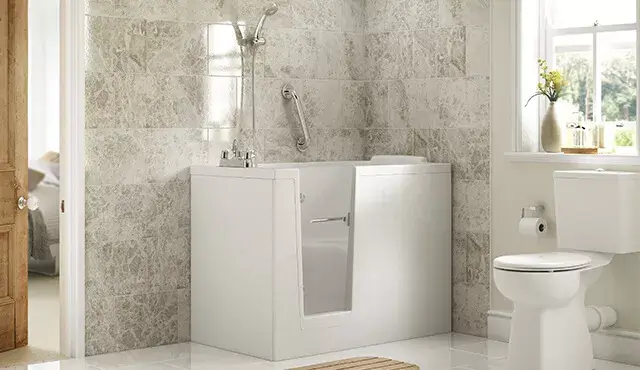
by Jon Pearce | 11th Aug, 2023 | Walk-in baths

Mobility-style baths, or walk-in baths, are an excellent alternative to traditional baths for those with mobility difficulties. These baths allow you to bathe in the comfort of your home without support and enjoy a safe bathing experience without putting strain and stress on your body.
In this article, we’ll uncover the safety features built into mobility-style baths and what to expect if you’re looking to purchase one.
Request a Free Brochure
Simply fill out a quick form and see how we can transform the way you bathe.
Request Free Brochure
- Features of mobility-style baths for safety
- Types of grab rails for walk-in baths
- Different grab rail styles
- Slip-resistant mats in walk-in baths
- Multi use shower head
- Low doors
- Thermostatic bath fillers
- Quick draining
- Built-in seat
- Sanitary coating
- How does a walk-in bath aid with bathroom safety?
Features of mobility-style baths for safety
Sit-in baths are designed for those with mobility issues, and below is a list of the safety features that help with this.
Types of grab rails for walk-in baths
Several variations of grab rails are incorporated in walk-in baths to make this type of mobility bath more accessible to everyone. Below are the types of grab rails available.
1. Straight Horizontal
These bathroom grab rails are installed where seating and standing is required, such as getting on and off a seat for a bath routine. These help push you down and support you when getting up off the seat.
2. Straight Vertical
Straight vertical grab rails are suitable for when a pulling movement is required. In particular, they’re great for assisting with you entering and exiting the bath and can aid with all types of weights.
3. Angled
Angled bathroom grab rails combine the benefits of vertical and horizontal benefits and help with either pulling or pushing movements. They’re typically found in baths, as they assist with various movements rather than having to have multiple grab rails installed.
4. Folding
If you have limited space in your bathroom, folding grab rails might be an excellent choice. They’re stylish and versatile, as they fold out when required and fold flat against a wall when not in use, helping create more space in a bathroom.
Different Grab Rail Styles
Aside from the various types of grab rails, there are various styles of grab rails available to complement your bathroom and suit your design choices. These can also aid with safety by improving grip and visibility.
1. High Contrast
Bathroom rails are available in bright colours to improve visibility for those with a visual impairment.
2. Slip Resistant
Hands rails are designed for safety, but the addition of a slip-resistant, gripped surface can further improve safety. This is something to consider for baths where there’s water present. Though you might want to consider that the surface will be rougher if you have sensitive hands.
3. Plastic Finish
A plastic-finish grab rail is more affordable than the alternative styles. While they might be more clinical-looking, they’re hard wearing and warm to the touch, which makes them a great choice in colder environments or if you have poor blood circulation.
4. Polished Chrome
This style is probably the most luxurious design, though the surface can become slippery when exposed to lots of water. If you opt for this style, consider installing it outside rather than inside the bath, to improve your safety.
Slip-resistant mats in walk-in baths
Aside from entering and exiting a mobility-style bath, a big safety predicament is slipping or falling while you’re bathing.
Thankfully, integrated non-slip mats on the surface of the bath help to minimise falls by adding texture to the bath floor. This provides texture for when you first get in the bath and lift yourself off to exit.
Multi use shower head
Not all walk-in baths include an integrated multi-use shower head. But those that do pivot to hard-to-reach areas come with various spray settings.
This allows you to rinse shampoo out of your hair without having to dunk your head underwater and move in an uncomfortable position. This function also allows you to shower in the bath for versatility.
Low doors
Mobility baths include a low door threshold, so you don’t need to lift your legs over the bathtub to get in and out, helping to reduce the risk of slips and falls. Some bathtubs are available with a wider door to accommodate users.
Additionally, all mobility-style bath doors are sealed to ensure that water remains inside the bathtub to prevent leaking onto the bathroom floor.
Thermostatic bath fillers
These bath fillers can make it easier to acquire the exact temperature you need without the risk of scalding water when you test the water or enter the tub.
Quick draining
You’ll need to drain the water out of the bath before opening the door, or you’ll risk water leaking everywhere in your bathroom. Thankfully, many mobility-style baths are equipped with a dual-drainage system.
This feature ensures that the water drains quickly, so you don’t have to sit in the bath waiting for a long time. This feature can help to speed things up. A faster draining system is not only more convenient but safer in the event you need to exit the bath quickly.
Built-in seat
One of the best bath aids for safety is a built-in seat. This makes it easier to clean yourself without having to lower yourself in the bath and then remove yourself, which can put unnecessary pressure on your joints.
The seats have a built-in textured surface to prevent you from sliding around and slipping while you get on and off the seat.
Sanitary coating
Some luxury mobility-style baths feature a sanitary coating to provide easier maintenance and prevent a build-up of mould and mildew. This is a useful feature if you live independently to prevent you from having to thoroughly scrub the bath after each use while getting peace of mind that it’s clean.
How does a walk-in bath aid with bathroom safety?
This type of bath with door access makes it easier to enter and exit the bath. The doors are designed at a low height to avoid you having to step over to enter and exit the bath.
A low threshold makes it easier to get in and out of the bath if you have mobility issues compared to stepping over the side of a traditional bath.































